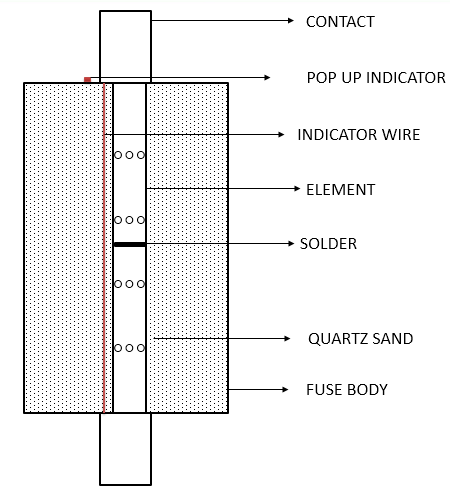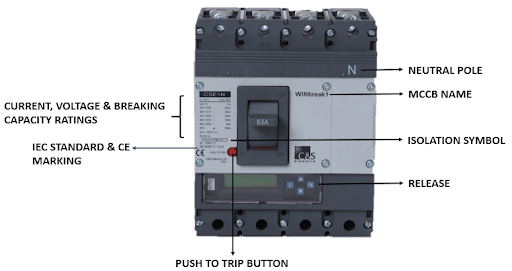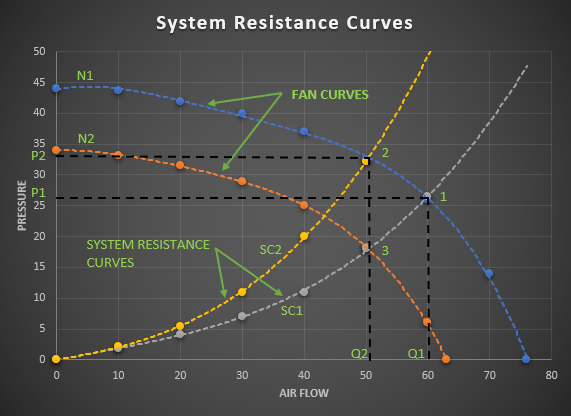Table of Content
1. What is Fuse?
2. As per IEC 60269, the fuse can be identified as mentioned below:
3. What is Circuit Breaker?
4. Key differences between Fuse & Circuit Breaker
In an electrical system ‘Fault’ is the condition which arise due to the malfunctioning of some component or wrong electrical practice. The fault may lead to a very dangerous situations such as explosion & fire if not cleared timely, not only this the amount of time for which fault persists in the system it continuously deteriorates the system health causing high energy losses resulting in increased thermal stress upon the system. From the above paragraph, it is clear that the faults are hazardous to the system & requires to be cleared at the soonest thus, there is a need of such device which not only is capable of clearing the fault but also have a lower opening time in order to save the let-through energy & minimize the thermal stress. Fuse & Circuit Breaker are the devices that fulfill the above criteria of the protection device i.e. capability of clearing the fault & also have a lower opening time hence saves the let through energy as well.
What is Fuse?
Complying with IEC 60269, fuse is a device that blows in case of a fault & can offer protection up to 80KA even beyond that. Whenever there is a fault in the system the fuse blows off & protects the system by cutting off the supply. A fuse is generally made of a ceramic body, having an element, The body is filled with quartz sand as shown in the fig:
HIGH RUPTURING CAPACITY (HRC) FUSE
Whenever there is an overload in the system, the solder as shown, gets into a chemical reaction resulting in cutting off the supply. In case of short circuit the element gets torn due to the application of high electrodynamic force on the same because of high current such as short circuit. The blown fuse can be easily identified by the pop up indicator which pops up whenever the fuse interrupts. The function of quartz sand is to successfully quench the arc & absorb the pressure thus, not letting the fuse to explode. The fuse is the staunchest combatant of the system as it is the quickest interrupting device available in the entire electrical system. The fuse blown within 2-5ms hence saving the maximum amount of let-through energy.
As per IEC 60269, the fuse can be identified as mentioned below:
- The first letter is ‘a’ if the fuse is for short-circuit protection only; an associated device must provide overload protection.
- The first letter is ‘g’ if the fuse is intended to operate even with currents as low as those that cause it to blow in one hour, ex. Overload. These are considered general-purpose fuses for the protection of wires.
- The second letter indicates the type of equipment or system to be protected:
- G – General purpose protection of wires and cables
- M – Motors
- PV – Solar photovoltaic arrays as per 60269-6
- R, S – Rectifiers or semiconductors as per 60269-5
- Tr – Transformers
Fuse although, is the most dependable & trusted protection device but can be used only one time, in no case the fuse can be repaired, after it blows off it only needs to be replaced.
What is Circuit Breaker?
A circuit breaker is a switching device which also offer protection against short circuit. Unlike fuse the circuit breaker do not blows off, but trips whenever there is a fault. The circuit breaker complies with IEC 60947-2 & can offer protection up to 150KA even beyond that, also a circuit breaker can offer a no of protections such as against:
- Overload
- Short Circuit
- Under Voltage
- Neutral
- Earth Fault
A typical labelled diagram for the circuit breaker is as shown below:
MOULDED CASE CIRCUIT BREAKER
A circuit breaker is not required to be replaced after tripping once, instead it must complete its total no of operations as declared by the manufacturer. The tripping time for the circuit breaker may vary w.r.t its type, for ex. the trip time for MCCB is less than 10ms & the opening time for ACB shall be less than 30ms. Not only this, MCCB also has a dedicated position for tripping, whenever the MCCB trips, its actuator lever comes in between i.e. neither in ‘ON’ nor in ‘OFF’ position.
According to the medium of arc quenching circuit breaker can be differentiated as below
| SNO | MEDIUM OF ARC QUENCHING | CIRCUIT BREAKER |
| 1 | AIR | ACB, MCCB |
| 2 | VACUUM | Vacuum Circuit Breaker |
| 3 | GAS | SF6 Circuit Breaker |
| 4 | OIL | Oil Circuit Breaker |
For tripping the circuit, a circuit breaker requires a release which senses the fault & gives a tripping command to the circuit breaker.
As per the method of tripping, the circuit breaker can be below types
| SNO | METHOD OF TRIPPING | CIRCUIT BREAKER |
| 1 | BIMETAL (for Overload) & Armature (for Short Circuit) | Thermal Magnetic Type |
| 2 | ELECTRONIC | Microprocessor Type |
Today the circuit breaker not only offers protection, but also has other features such as Annunciation, Current, Voltage & Power Metering, Communication capability, Energy Measurement etc. which differentiate it from the fuse, also the use of circuit breaker leads to lower maintenance time, lower inventory & finally cost saving. Despite the above advantages of the circuit breaker over fuse, the fuse still has a higher hand on the circuit breaker & that is because of its tripping time which is minimum, which is why in few applications fuse is used even at the upstream of circuit breakers.
Key differences between Fuse & Circuit Breaker
| SNO | PARAMETERS | FUSE | CIRCUIT BREAKER |
| 1 | MAINTENANCE | Fuse can only be used 1 time, it is a non- reusable device | Circuit Breaker can offer total no of operations as declared by manufacturer. |
| 2 | TRIP TIME | 2-5ms, quickest operating device | Vary as per the device, ex: for ACB it can be 30ms & for MCCB can be less than 10ms |
| 3 | UTILIZATION CATEGORY | If first letter is ‘g’ means both protection (O/L + S/C), If first letter is ‘a’ only S/C will be there. | If category A it means no Icw shall be there, If category B, Icw shall be there |
| 4 | METHOD OF TRIPPING | ‘SOLDER’ for Overload, ‘ELEMENT’ for Short Circuit | Available as ‘MICRPROCEESOR’ type & ‘THERMAL MAGNETIC’ type |







No comments:
Post a Comment